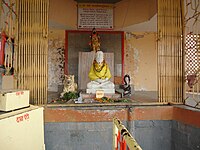Samadhi (shrine)

In
mahāsamādhi, or were already in samadhi
(a state of meditative consciousness) at the time of death.

In Sikhism, the term "samadhi" is used for the mausoleums of eminent figures, both religious and political. Examples include the
chatri, often placed around a temple.[citation needed
]
The tradition of India is cremation for most Hindu people at the time of death, while samadhi is generally reserved for very advanced souls, such as yogis and saints,[4] who have already been "purified by the fire of yoga"[5] or who are believed to have been in the state of samadhi at the time of death. Samadhi usually involves inhumation rather than cremation.[4]
Examples
One of the popular site of pilgrimage in India is the town of
Varkari saint Dnyaneshwar took Sanjivan Samadhi, or entombed himself in the state of Samadhi. His devotees believe that he is still alive.[6][7]
ISKCON
(known as the "Hare Krishna Movement"), is commemorated with a large Samadhi Mandir in
Mayapur, West Bengal.
-
Samadhi of Sri Adi Shankaracharya
-
Samadhi of theMaratha admiral Kanhoji Angre
-
Samadhi with image, Maharashtra
-
Samadhi ofChatrapati Shivaji Maharaj, Pachad, Raigadh, Maharashtra
See also
References
- ^ "Hindi dictionary (Samadhi)". Retrieved 18 September 2014.
- ^ "Oxford Dictionary – American English". Archived from the original on October 22, 2013. Retrieved 18 September 2014.
- ^ "Oxford Dictionary – English". Archived from the original on October 22, 2013. Retrieved 18 September 2014.
- ^ OCLC 301680132.
- ^ Georg Feuerstein, The Encyclopedia of Yoga and Tantra (Boston: Shambhala Publications, 2011), p. 308.
- ^ Novetzke 2009, p. 218.
- ^ Glushkova 2014, p. 116.
Bibliography
- Glushkova, Irina (2014), Objects of Worship in South Asian Religions: Forms, Practices and Meanings, Routledge, ISBN 978-1317675952
- Dallmayr, Fred (2007), In Search of the Good Life: A Pedogogy for Troubled Times, University Press of Kentucky, ISBN 978-0813138589
- Novetzke, Christian Lee (2009), Shared Idioms, Sacred Symbols, and the Articulation of Identities in South Asia, Routledge, ISBN 978-1-135-90477-7
External links
Look up samadhi in Wiktionary, the free dictionary.
 Media related to Samadhi (shrines) at Wikimedia Commons
Media related to Samadhi (shrines) at Wikimedia Commons- Spiritual Travel – Samadhis of the Sages








